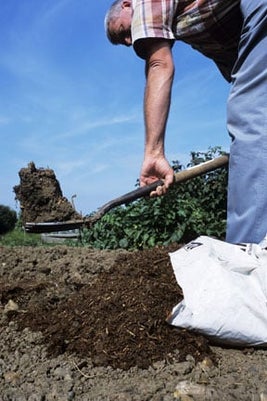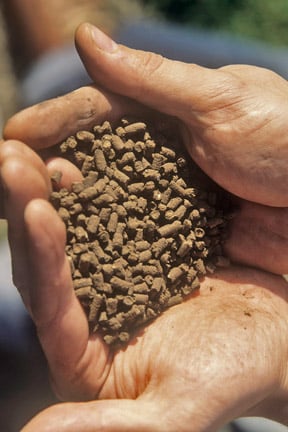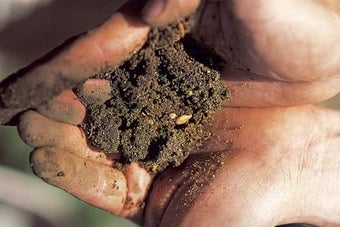
Quick facts
‘Soil improver’ and ‘soil conditioner’ are alternative names for organic matter
Manures provide some plant nutrients, but some ‘hungry’ plants require fertiliser to give their best
They can be used to improve soil, growth and yield, as well as supress weeds
Manures and composts often prevent plant nutrient deficiencies
Organic matter improves soil structure and fertility
Why use organic matter?
Naturally occurring organic matter in soils
In natural landscapes untouched by cultivation soil the organic matter in soils is governed by the carbon cycle. Here plants photosynthesize and add organic material to the soil though their roots, fallen leaves and eventually when they die. This then rots and becomes part of the soil organic matter. The soil organic matter in turn rots and releases carbon dioxide that in turn is used by plants in . Animal matter too is returned to the soil - all animals ultimately feed on plants. To learn more about what is meant by organic matter, have a read of our page: Organic matter: what is it?
Under natural conditions in cool climates organic matter accumulates in natural soils to fairly high level where gain balances losses, but upon cultivation soil organic matter falls as man made vegetation usually supplies less organic residues then natural vegetation, and the effects of tillage (digging, raking, ) lead to a higher rate of soil organic matter loss. Ultimately the soil organic matter can fall to levels where the soil function is impaired. Most soils in southern England have less than 2% organic matter, but in the rest of the British Isles 2-6% may be found.
Organic matter in soils binds other soil particles into aggregates that can be penetrated by roots and hold moisture, provides binding sites for so they are not washed out of the soil by rainfall and as it decays releases plant nutrients to feed plants. Typically this soil organic matter decays very slowly.
Soil organic matter is also present as free organic matter derived from plant or animal remains or from recently added manures and composts. This decays quickly but some of it will be converted to longer lasting forms bound to soil minerals.
Enriching garden soils with organic matter
Gardeners (and farmers) aim to manage the levels of soil organic matter to get acceptable plant growth, which will typically mean that organic matter levels should be 3-6%. The main way they do this is to add organic matter. Because the effects of organic matter are so pronounced it is feasible to add sufficient organic matter to improve soils in a way that would be very difficult to add, say clay to a sandy soil and vice versa. Because clay and sand are not very effective in small quantities enormous amounts would have to be mixed into the soil to make a real difference.
Natural soils contained 30-40% more organic matter than they now contain under cultivation. Good garden plants can be grown at lower levels of organic matter than found in virgin soils, but once organic matter levels fall to below 2% the impact can be severe. A fall in soil organic matter of 0.5% can reduce, for example, nutrient holding capacity by 4% of even fertile soils.
Happily there is no need to test soils as it is relatively easy to judge whether a soil is manageable and add more organic matter if you encounter difficulties in make seed beds, planting or if the soil dries out in summer. With experience it is quite feasible to maintain enough soil organic matter to garden, and there is no need to add more than the minimum required to do this. A soil that is light coloured and sets solid when wet or dry is likely to require organic matter.
Choosing organic matter
Home made garden compost is ideal on cost, quality and environmental grounds. Gardeners that do not have facilities for home or cannot make sufficient for all their needs, will need to buy in extra. Organic matter is sometimes sold simply as 'soil improver' or 'soil conditioner'. See our introductory page on organic matter for a list of types.
As organic matter is used in bulk, applying 5-10kg (10-20lbs) per square metre (yard) bulk sources are usually much more economical that bagged or baled material. However, bagged or baled materials can often be bought by the pallet load when the price difference with bulk materials is less. In many small gardens a few bags of organic matter are sufficient, and in some urban areas all that is available.
In rural areas manure is available from farms and stables, either delivered or for collection. The rules on trade wastes should be borne in mind (see problems below). Similarly mushroom farms often offer spent mushroom compost.
Municipal compost is now offered by councils or contractors, and can be a cost-effective source (but note the need to test for weedkiller residues - see problems below). Composted wastes, stable manure for example, are frequently available.
Less widely offered materials such as spent hops from local breweries can be a cost effective choice.
Ideally materials should be in a well-rotted state, especially manures. In some cases un-rotted or partially rotted organic matter is offered; these will not look as dark or as uniform in texture and colour. On sanitary grounds these materials are best stacked, covered and used when decomposition is complete. If used fresh apply at half the usual rate and not to ground used for crops that will be eaten raw (e.g. salads).
When to use organic matter
Organic matter contains soluble or mineral and organic molecules that contain nutrients. The action of soil microorganisms turns the latter into soluble nutrients. Microorganisms work quickly in summer, but slowly or not at all in winter.
Digging in organic matter
Well rotted composts and manures will be relatively poor in soluble nutrients but rich in insoluble ones. On most soils they are best incorporated by cultivation in spring (March and April in most of the UK) just before growth starts. Sandy soils are best manured from late winter. However, autumn application can also work on all but sandy soils. The cold soil will slow breakdown over winter. Avoid applying in late summer as the warm soil can lead to significant nutrient loss as the materials will breakdown quickly to produce soluble nutrients easily washed out (leached) by winter rains. On a garden scale it is often feasible to cover vegetable beds with a plastic sheet to shed excess rain and retain valuable nutrients.
Fresh manures are rich in soluble nutrients and are best composted before use but if applied fresh best done in spring so the soluble nutrients are not washed out into ground water, ditches or drains where they can be a pollution hazard - see Problems below.
Using as a mulch
For mulching late winter or early spring (February and March in most of the UK) is the ideal time as there will be little loss of nutrients, any soluble nutrients will be washed into the root zone by the last of the winter rains, winter rain will be protected form evaporation and weeds will be prevented from as the soil warms in spring.
Storing
Organic matter can be stacked and stored for use later. Aim to make a stack on the smallest feasible 'footprint', cover with rainproof material to prevent nutrients being washed out and to exclude weed seeds, and ensure any run-off does not enter drains or ditches, and ideally be collected and applied to the garden.
Applying organic matter to the garden
Organic matter can be used in two ways;
- As a soil improver/conditioner to dig into the soil: only use materials that are well-rotted (i.e. composted) to avoid depleting nitrogen from the soil. Examples include garden , composted , composted , leafmould, well-rotted manure.
- As a on the surface of the soil: a wider range of materials can be used since there is less in contact with the soil surface than when dug in. As a general rule, the coarser the material, the longer it will take to break down. Examples include bark, woodchip, shredded woody waste, as well as the examples given above in no1.
Using as a soil improver: how much to apply
To improve soil it is usual to apply about 5-10kg (11-22 lbs) per square metre (yard) which is generally about half to one 15L (3gallon) bucketful. It is worth checking this with a suitable weighing machine or balance, as wet manures and garden composts will be much heavier than drier materials such as mushroom or municipal compost. Naturally more wet material should be applied than drier organic matter.
Using as a mulch: how much to apply
For weed control as mulch or as surface application as a part of no-dig gardening at least 5cm (2ins) is required which amounts to about 50litres (11 gallons) per square metre (yard). In practice it is easier (and more effective) to apply 8cm (3ins) requiring about 50% more organic matter.
Reducing the need for fertilisers
Using organic matter can save on fertiliser costs. Manure is likely to contain about 0.6% Nitrogen (N), 0.1% Phosphate (P) and 0.5% Potash (K) and garden compost 0.5% Nitrogen (N), 0.3% Phosphate and 0.8% Potash. (Source: The Royal Horticultural Society Encyclopedia of Gardening 1992). Growmore, a widely used garden fertiliser, contains 7% of these nutrients, so as a rough guide (based on the most significant nutrient, nitrogen) 100g of Growmore can be replaced by 1300g of manure or compost. Remember, however, that the nitrogen will be released slowly with relatively little wastage and that manure will (unlike fertilisers) benefit soil structure.
For full details on nutrient content of organic matter consult this guide.
from organic matter are mainly available in the first and second year after application, with some decreasing benefit in the succeeding two years. On cultivated land applying organic matter every three or four years will maintain organic matter levels in the soil but to increase levels application might be required every or every other year. Once the soil has an organic matter content of 5% or greater the benefits of adding more organic matter are harder to justify.
A note on handling organic matter
Basic garden hygiene should be followed when handling organic matter avoiding eating, drinking and smoking , wearing gloves, wellington boots and overall and washing hands afterwards.

Problems
Weedkiller contamination: Inadvertent contamination has been encountered with some composts and manures. Where this is possible or suspected, do a germination test before using in the garden.
Nitrogen lock-up: This can occur where organic matter contains much carbon rich material in relation to its nitrogen content. Stable manure with wood chip bedding material present or chips have a low carbon to nitrogen ration and should be used with caution, adding extra nitrogen-rich fertiliser. Using high carbon materials as will not cause significant nitrogen lock-up.
Weed seeds: Manure from animals fed hay or where the manure has been stacked outside may contain weeds such as clover and nettles. Avoid weed contaminated manures, or use in situations such as shrub borders where a thick weed seed-free mulch can be applied, chipped bark for example, after manuring. Garden can also be troubled by unwanted seeds. Bought bagged composts/soil improvers tend to be lest prone as they are composted at a temperature high enough to kill off weed seeds.
Pests and diseases: Composted plant waste may contain diseases if the process was not sufficiently hot or diseased material was incorporated in the compost. Such compost is unsuitable for garden use but may be lightly spread on pastures or waste ground. Alternatively, it can be added to municipal composting facility to be composted industrially where sufficient warmth is likely to be generated to kill pests and diseases.
Pollution: from fertilised and manured land can contaminate water such aquifers and rivers. This is mainly an agricultural problem, but gardeners can help by following good practice. Don't over fertiliser or manure. Apply nutrients in the spring just before growth starts. Avoid using manures and fertilisers in late summer or autumn where they may be lost over winter and pollute water bodies. Note: Autumn lawn feeds are an exception as grass grows sufficiently in winter to pick up mobile nutrients form these feeds.
Waste regulations: Gardeners should be aware that animal and other wastes are strictly controlled, and although traditional usage of farmyard manure in gardens and allotments does not appear to be specifically mentioned, advice should be sought if large scale use of manures, composts or composting activities is intended. For more information see Animal by-product categories, site approval, hygiene and disposal.


























